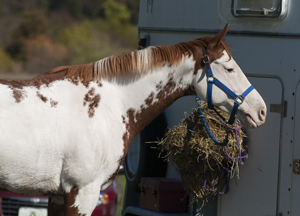Question: When I change direction across the diagonal of the ring, where is the best point at which to change my posting trot diagonal? I’ve heard different things from different trainers–some say to change my posting diagonal as soon as I leave the rail, others say to change at X and still others have instructed me to change just before reaching the rail going in the new direction. Who is correct?

Answer: This is a great question. High-scoring tests are made up of a multitude of small details and changing your posting diagonal smoothly is one of them. Judges don’t care where you change your diagonal; they just want to see a seamless ride with no loss of balance, contact, straightness or any other disruption of the general flow of the test. When you change your diagonal, there’s always a risk that you might sit too heavily or bounce slightly in the saddle, causing your horse to stumble or drift off his line, or that you might experience a momentary loss of connection in the reins, resulting in his head lifting off the contact. A little strategizing can help to minimize these bobbles.
The goal is to make the change when your horse is most balanced and steady in the contact. This is more likely when he’s bending, rather than straight, and when he feels the “support” of the rail beside him. So you want to make the change on either the turn onto or at the end of the diagonal. (As an added benefit, any slight bobble is usually less obvious to the judge in a corner than at X.)
Which turn is better? That depends on where your horse will be most comfortably balanced, which most likely will be when he is turning toward his “softer” side. Almost all horses are softer–easier to balance and bend–on one side than on the other. If you don’t know which is your horse’s better side, ride him several times on a 20-meter circle in both directions. You’ll find it easier to steer him and maintain your own balance on his softer side and slightly harder and less comfortable to ride him on his stiff side.
Use this knowledge to plan your test. If your horse is softer on the right side and you’re turning across the diagonal, say, from K-X-M, change your diagonal in the first corner as you’re bending right. If he’s softer on the left side, change it in the second corner as you’re bending left. And going in the other direction, say, from H-X-F, if he’s softer on the right side, make the change in the second corner. If he’s softer on the left, make it in the first.
Also consider whether your horse is steadier in the contact on one rein than on the other. Some horses get fussy when you change your posting diagonal from their “favorite” rein to the other rein. They’ll make a better impression on the judge if you cross the ring on their preferred diagonal. So, for example, if you enter the first corner traveling in the direction in which your horse is usually quieter, wait until the second corner to change your diagonal. The bend around the turn will help you get him solidly on the new rein before you have to straighten. If the first turn is in the direction he doesn’t prefer, plan to change your diagonal in the corner before you start across the diagonal.
Time your change carefully so it doesn’t disrupt the rest of your ride. For example, if you plan to do it in the first corner, ask for a soft bend around the corner. Then make the change as your leg passes the letter and you begin your turn off the rail, and look ahead to the letter you’re aiming for–or just a stride or two before that. If you get flustered and forget to change your diagonal, don’t try to do it on the straightaway. Instead, wait until you reach the letter on the far rail and begin your turn around the next corner. Again, take advantage of your horse’s balance while he’s bending. So long as you make the change before you straighten onto the short side, the judge won’t mind.
Changing posting diagonals is one of those balancing acts that needs to be worked out between each horse-and-rider pair; what works with one horse may not work with another. To find what’s best for you and for your horse, practice different variations at home, on both short and long diagonals. Compare how your horse’s balance and contact feels when you change the diagonal in the first or second corner in both directions.
Also experiment with standing up two beats, rather than sitting two beats, to make the change. Many riders find it easier to maintain their own balance and rein contact when doing the former. Be sure to practice it at home until it’s second nature before trying it in a show. And remember, the more smoothly you can change your posting diagonal, the better impression you’ll make on the judge.
Based at her Sunrise Stables in Fort Davis, Texas, U.S. Dressage Federation (USDF) gold medalist Whit Watkins has trained with Olympian Hilda Gurney for 20 years. In 2008, she swept the USDF Region 9 Championships with four wins: Open Second Level, Second Level Freestyle, Open Third Level and Open Fourth Level. Whit’s students range from 3-year-old children to seniors in their 70s, and from beginners to FEI-level riders. She also teaches across disciplines, sharing her dressage expertise with Western, polo, trail and event riders.
This article originally appeared in the June 2009 issue of Practical Horseman magazine.










